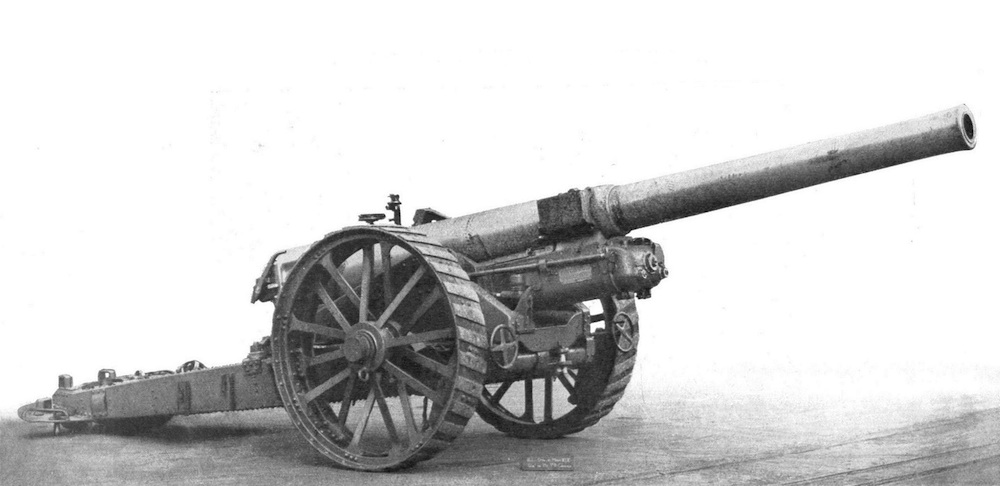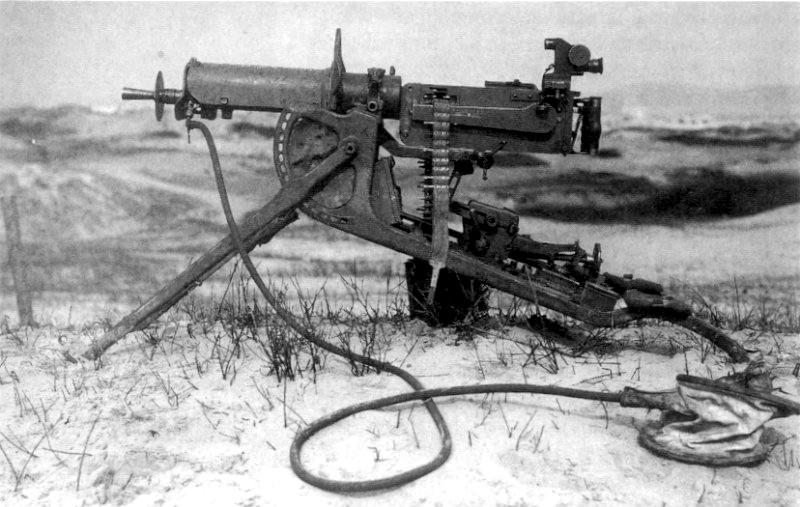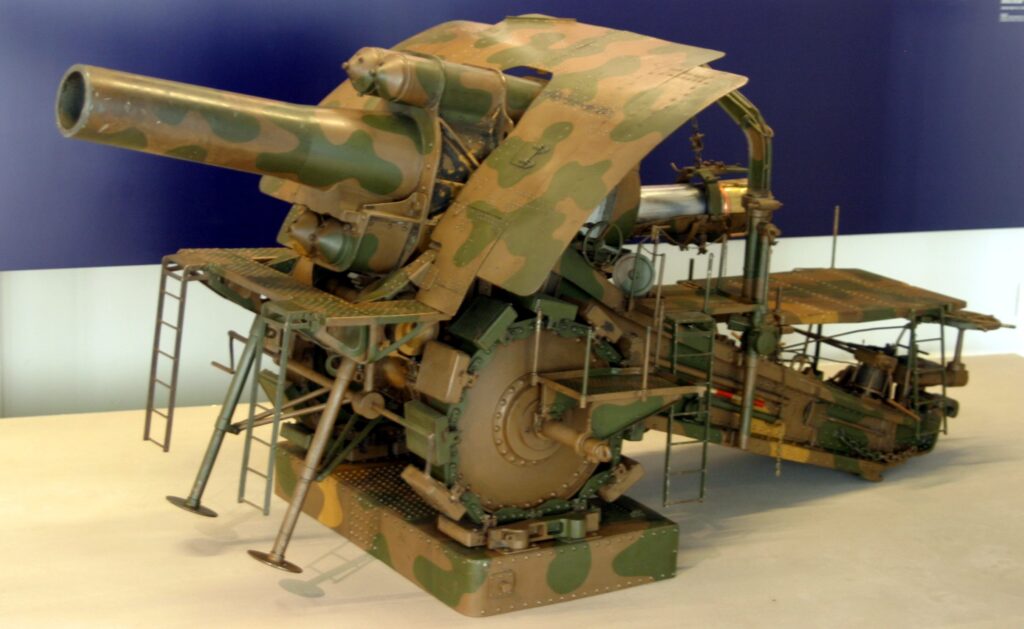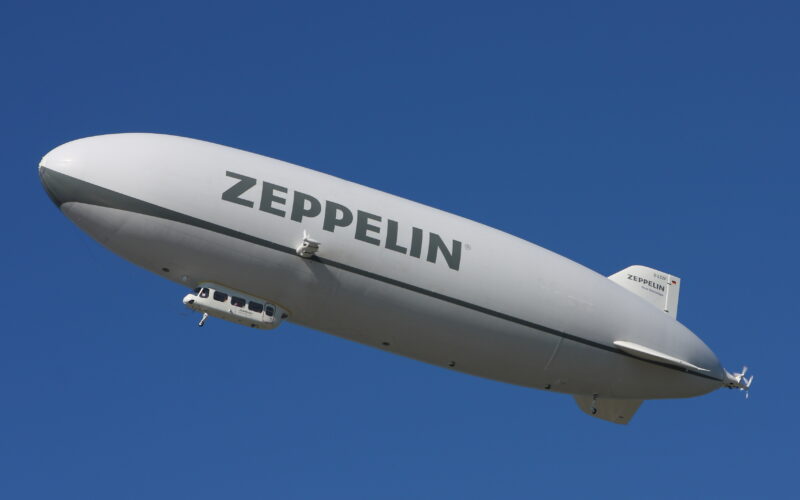There are Top 15 Weapons World War 1 to know in 2022 that not only killed multiple people at once, but also caused immense physical and mental violence. The First World War is considered as one of the biggest and most tragic wars in the history of mankind. Even though war was not something new to human civilization, in World War I, for the first time, people witnessed a very well planned used of technology for the sake of destruction. The surviving soldiers often suffered with trauma and PTSD for the rest of their lives. Here is a list of 15 deadly technology and Top 15 Weapons World War 1 to know in 2022 .
Artillery Gun

Weapons World War 1 featured several advances in weaponry, but artillery pieces dominated the conflict. Their major goal was to shoot massive amounts of explosive-filled projectiles across long distances.
Light field artillery driven by horses and bigger cannons pulled by tractors were the two major types of artillery employed in combat. Field artillery used flat-trajectory guns with calibres ranging from 7.5 to 8.4 cm. Big artillery also featured heavy mortars and unique weapons for fighting new armoured turret positions. During the war, artillery was used more often, and by the course of the war, there were a lot of them. Artillery personnel made up 20% of the French army in 1914, and by 1918, that number had risen to 38%.
Maxim MG 08 Machine Gun:

The Maxim MG 08, also known as the Maschinengewehr 08, was a derivative of Sir Hiram S. Maxim’s original machine gun, the world’s first fully automated machine gun system, which he invented in 1884. It was one of the most brutal Weapons World War 1. The fire rate for the Schloss 08 was 500 rounds per minute, while the firing rate for the Schloss 16 was 600 shots per minute. It was water-cooled to minimise overheating, with a jacket around the barrel holding around one gallon of water.
The MG 08’s realistic range was assessed to be 2,200 yards with a maximum range of 4,000 yards. During the First World War, the German army created an exact duplicate and used this Weapons World War 1. During the Battle of the Somme in 1916, the British lost 21,000 troops in a single day.
Chloramine and Mustard Gas:
Chloramine is one of a group of chemical Weapons World War 1 witnessed. It is a vomiting agent or sneezing gas. It was meant to momentarily cripple and intimidate enemy troops by causing short-term but severe respiratory discomfort. In 1917, the Germans were the first to employ mustard gas. Large blisters on the skin and lungs were produced by mustard gas or sulphur mustard. Mustard gas was difficult to detect unless it was used in a direct attack.
Soldiers were typically able to recognise it because of its peculiar odour, but gas masks were frequently insufficient since the gas pierced the filters and mask housing. British forces suffered 160,526 wounded and 4,000 fatalities as a result of gas shells containing chlorarsine, mustard gas, and phosgene. These gases would generally be exposed in tunnel or confined spaces, causing the soldiers inside to suffocate if they can not put on the masks on time.
Phosgene and Tear Gas:

Poisonous gases caused about 1 percent of wartime fatalities. Not only did they induce extreme physical pain or death, they also caused PTSD in soldiers and disfigurement of their face. Various sorts of chemicals were used in chemical warfare during WW I. Tear gases were not intended to kill, but rather to leave the opponent defenceless. This Weapons World War 1 gas had an effect on the eyes and lungs, but it went away within 30 minutes. Phosgene was the second chemical utilised in conjunction with chlorine. The symptoms could take up to 48 hours to appear. It led in a build-up of fluid in the lungs, leading to death.
Barbed Wire:
Invented for cattle fencing in the nineteenth century, barbed wire gradually made its way into modern combat. During the battle, this wire turned out to be a devastating Weapons World War 1. Typically, the wire was set out in long crisscross strips or belts corresponding to the trenches. Wire fields, notably on Germany’s heavily constructed Hindenburg Line, went as far as 91 metres into no man’s land, making the area gloomy and thick even during daytime hours. Soldiers utilised wire to protect trenches and indicate no man’s land, as well as to draw an adversary into slaughter zones with artillery target areas and machine guns.
Type 93 U-Boat:

During World War I, the Type 93 U-boat was one of the most devastating Weapons World War 1. The term “U-boat” is derived from the German phrase Unterseeboot, which means “undersea boat.” The German Imperial Navy constructed the Type 93. U-boats of the Type 93 had 16 torpedoes and were equipped with deck guns. Some only had one 8.8cm deck cannon, while others only had one 10.5cm deck gun with 140 rounds.
In 1917, a single 10.5cm cannon with 220 rounds was installed on some of the boats. These boats carried a crew of 39 people and had exceptional seagoing capabilities, with a cruising range of around 17,000 kilometres. During the war, these boats were involved in destroying around 3% of all Allied cargo.
Q-SHIPS:
In the early years of the war, Britain built the Q-ship, a commerce vessel with this hidden Weapons World War 1, to counteract the threat of U-boats. The U-boats were required by the Kaiser to surface before firing their guns upon commercial ships. The Q-ship would open fire on the surfaced submarine at the last possible moment, destroying it. In 1916, Germany initiated unrestricted U-boat warfare, torpedoing commerce ships while underwater, putting a stop to the Q-ships’ efficacy. In the end, it was the British convoy strategy, in which warships protected commerce ships, that destroyed the U-boats.
Big Bertha:

Big Bertha was the biggest and most powerful type of mobile artillery in service by any army at the time of its development . This Weapons World War 1– artillery piece was given the moniker Big Bertha in honour of Bertha Krupp von Bohlen und Halbach, the owner of the Krupp business that manufactured the weapon. It was a 420mm howitzer used by German soldiers in 1914 as they advanced into Belgium.
The cannon had a range of around nine kilometres and could fire projectiles worth up to 1,785 pounds. A delayed-action fuse, which exploded after piercing up to 40 feet of concrete and dirt, was the most common type of shell used in Big Berthas. One of its bullets entirely demolished the Fort de Loncin during the Siege of Liège, Belgium.
Fokker Triplane:
The Fokker Triplane is the most well-known plane from Weapons World War 1. It was Germany’s answer to Britain’s famed Sopwith Triplane. It was piloted by Manfred Albrecht Freiherr von Richthofen, better known as the Red Baron. He shot down at least 70 allied planes, including 19 with his Dr.1. The Fokker D.VI Triplane’s top wing had ailerons, and the lower and centre wings were fuselage-mounted. The upper wing was linked to the fuselage by steel tube struts and was located above the fuselage. The D.VI was equipped with two synchronised 0.31-inch LMG 08/15 cannons and was powered by 110hp engine.
Mark V Tank
The Mark V tank was the final and biggest British tank to service in Weapons World War 1. It had a negligible overall impact on the conflict. It was a Mark IV that had been tweaked. To prevent manufacturing interruption, the Mark V retained the Mark IV’s outward elements, such as the hull, rollers, and tracks. In early 1917, however, a new, more powerful powertrain and transmission were introduced.
Wilson’s own epicyclical gearbox design was among these systems, which featured petrol-electric schemes, hydraulic systems, a multiple clutch system with a single driver, and a multiple clutch system with a single driver. A new 19-liter six-cylinder in-line Ricardo engine was also installed, which was more powerful. The Mark V saw action in eight important battles before the war’s end.
Zeppelin

One of the first airships to be employed in the war was the Zeppelin. Count von Zeppelin, a former German army commander, designed it. Airships, also known as dirigible balloons, are lighter-than-air aircraft that can move through the air on their own power.
Large gas bags loaded with lifting gas that is less dense than the surrounding air provide lift for these sorts of aerostat aircraft. Although airships had been employed before to the conflict, thisWeapons World War 1 was during the war that the airship made its debut as an air weapon. The Germans utilised hydrogen-filled Zeppelins capable of cruising at 85 mph and carrying up to two tonnes of bombs in the early days of the conflict.
Aircraft
Aside from Zepplin, a number of other aircrafts were built for service in the conflict. Most military and political leaders underestimated the use of this incredible new technology and Weapons World War 1. Before long aircraft were armed with machine guns, they were only employed for reconnaissance. The aeroplane became a genuine Weapons World War 1 once Anthony Fokker devised a means to coordinate the discharge of a machine gun with the spinning of the propeller.
Early planes were frail, kite-like creations made of light wood, canvas, and wires. In 1914, the 80–120 horsepower engines generated peak speeds of fewer than 100 mph; four years later, the highest speed had nearly quadrupled. Pilots’ protection remained illusive, but most pilots despised the idea of wearing parachutes nonetheless. Multi-engine bombers were developed throughout the conflict.
Flamethrowers
As far back as ancient China, reports of troops utilising some type of flame-throwing contraption may be discovered. During the Civil War in the United States, several Southern publications said that Abraham Lincoln had seen a test of such a weapon. This Hand-held Weapons World War 1– flamethrowers were first used in battle on February 26, 1915, when the Germans deployed the weapon at Malancourt, near Verdun. Nitrogen pressure was utilised to spray fuel oil from tanks carried on a man’s back, which was ignited as it exited the muzzle of a tiny, hand-directed pipe. Over 650 flamethrower attacks were launched by Germany’s 3,000 Flammenwerfer forces during the conflict.
Mortars
Even though mortars had been in use for some time, this Weapons World War 1 were far more advanced than their predecessors. The Stokes mortar, which had no moving components and could fire up to 22 three-inch rounds per minute with a range of 1,200 yards, was introduced by the British in 1915. The Germans created a mortar with a 10-inch barrel that shot metal-ball-loaded rounds.
Powerful Rifles
The firearms that the major fighters used the most Weapons World War 1. The Central Powers used rifles like as the Steyr–Mannlicher M95, Mauser M98G 7.92mm, and Mauser M1877 7.65mm that had been created. The Springfield employed a bolt-action design that was sufficiently similar to Mauser’s M1989 that the US government had to pay Mauser a licence fee, a process that persisted until America entered the war.

